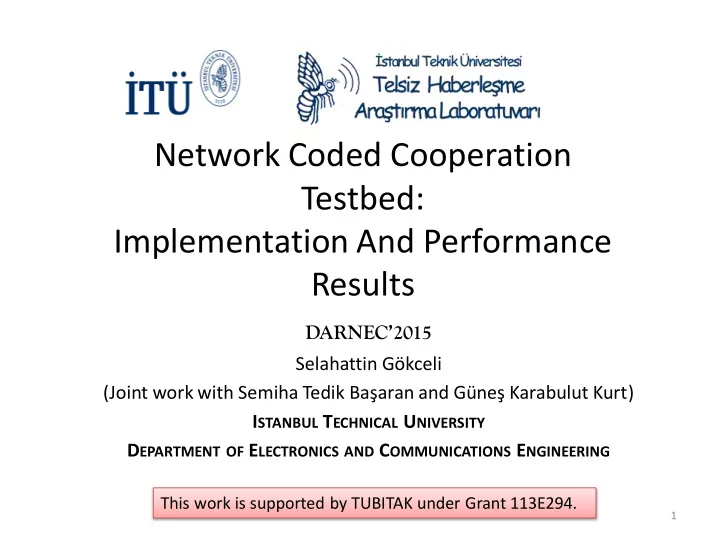

Network Coded Cooperation Testbed: Implementation And Performance Results DARNEC’2015 Selahattin Gökceli ( Joint work with Semiha Tedik Başaran and Güneş Karabulut Kurt ) I STANBUL T ECHNICAL U NIVERSITY D EPARTMENT OF E LECTRONICS AND C OMMUNICATIONS E NGINEERING This work is supported by TUBITAK under Grant 113E294. 1
Outline Motivation System Model Testbed Details - NCC System - Image Transmission Structure Test Results 2
Motivation Current status of Wireless Networks-5G Resource scarcity problems Increasing number of users Constant (or decreasing) radio resources Increasing data rate demands 3
System Model(1/2) Set-up includes three source nodes (M =3) , one destination node (P = 1) and one relay node (K = 1). -OFDMA uplink transmission is realized in the broadcast phase . -In the relaying phase, the relay node uses all N=1200 subcarriers. -X i and X k signals from source nodes and relay node are transmitted with 4-QAM modulation, respectively where (i = 1 ,…, M and k = 1 ,…, K). 4
System Model(2/2) The global coding matrix of the total system in GF(4) is set as Although we use a single physical device as the relay node, we use the same subcarrier set for the relaying phase (i.e. 320 subcarriers). Three linear combinations of the received source symbols are generated at the relay node. Hence, the coding matrix becomes of dimension 3x6. In the end, a cooperative detection rule is used at the destination node. 5
Testbed Details (1/14) Hardware Components: - NI USRP-2921: Source and Destination Nodes, Instantaneous bandwidth up to 20 MHz - NI PXIe-1082 Chassis: - NI PXIe-5644R VST: Relay Node, Instantaneous bandwidth up to 80 MHz - NI PXI-6683: Clock Signal Source 6
Testbed Details (2/14) Hardware Components: 7
Testbed Details (3/14) Synchronization Solution: - Three external 10 MHz signals are provided by NI PXI-6683 Timing and Synchronization Module - These signals are transmitted to two source nodes and destination node via cables - Remaining source node receives synchronization signal through MIMO cable - Synchronization configuration in code 8
Testbed Details (4/14) Software Components: -LabVIEW Software: Visual Programming Language, Programming with Virtual Instruments (VI) -Timed Flat Sequence Structure: Main VI of the code, consists of: -Source, relay and destination node SubVI -Network coding and decoding SubVI 9
Testbed Details (5/14) Timed Flat Sequence Structure VI Block Diagram: 10
Testbed Details (6/14) Source node SubVI implementation structure: 11
Testbed Details (7/14) Relay node SubVI implementation structure: 12
Testbed Details (8/14) Destination node SubVI implementation structure: 13
Testbed Details (9/14) Example of LabVIEW implementation: - Relay SubVI’s transmitter code: -RFSG VI -Modulation Toolkit VI -Signal Processing Library VI -Array functions 14
Testbed Details (10/14) Correspondent SubVI: 15
Testbed Details (11/14) Network Decoding and ML Estimator SubVI: 16
Testbed Details (12/14) Image Transmission Implementation: -Packet Transmission Algorithm: -Dividing 100x100 pixel images to packets - Index Portion: Shows packet’s index number, %5 of the frame length - At Rx, by using index portion, packets are determined and put in right order to form image 17
Testbed Details (13/14) OFDMA Frame Structure: 18
Testbed Details (14/14) Set-up Parameters: 19
Test Results (1/5) Received 4-QAM Constellation Diagrams: 20
Test Results (2/5) NCC System Test Results: 21
Test Results (3/5) Link performance comparison for S3 data at 4 dB gain. The relay gain is -23 dBm . 22
Test Results (4/5) BER performance comparison of the links in the image tranmission implementation 23
Test Results (5/5) Received image at direct link and network decoder: 24
Conclusions Provide efficient usage of limited resources NCC is very effective on improvement of transmission quality of OFDMA based transmission Reliable communications against imperfect effects of wireless fading channel Suitable for applications such as multimedia transmission 25
Thank you! This work is supported by TUBITAK under Grant 113E294 & COST IC1104 26
Recommend
More recommend